00:00
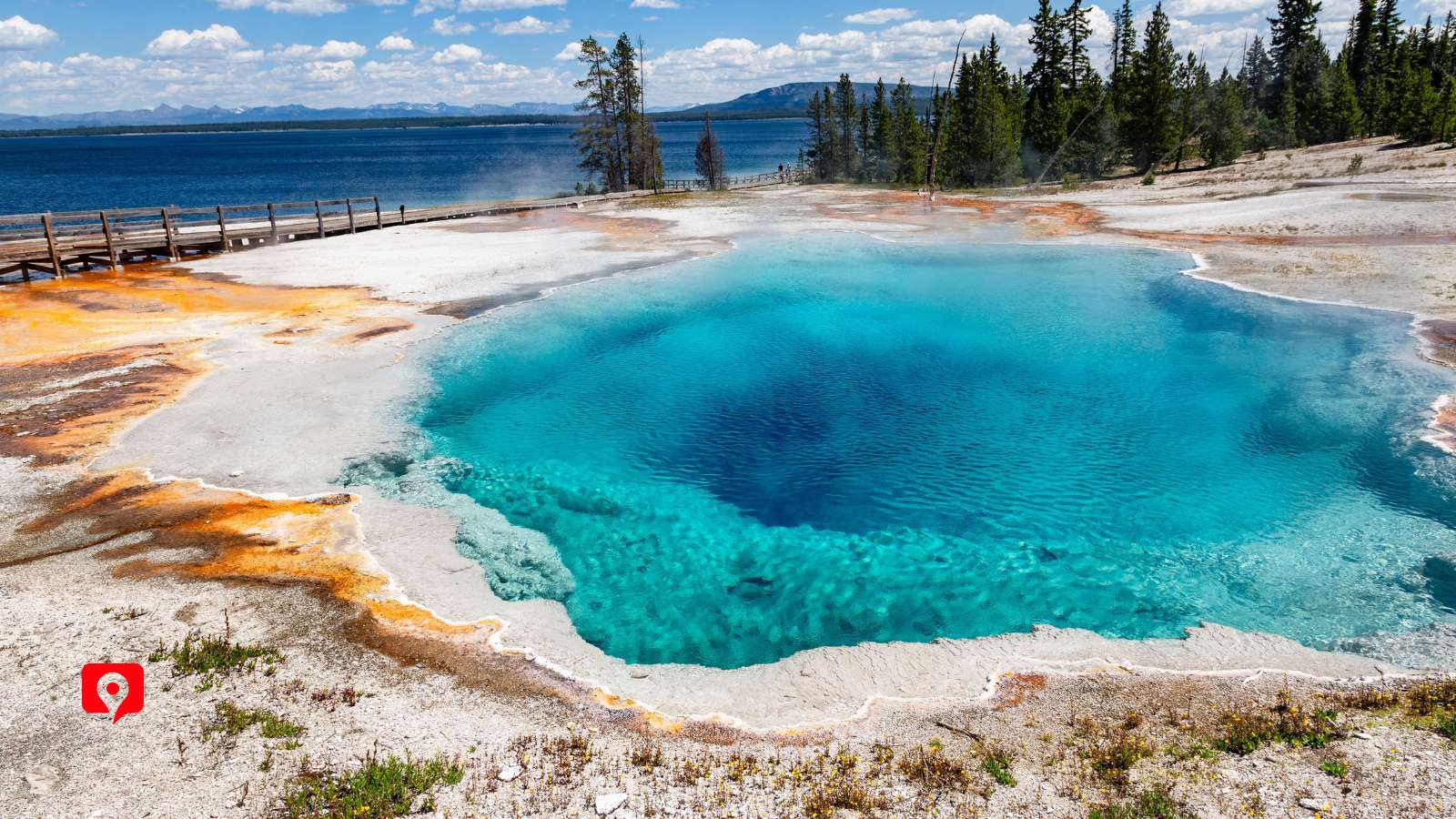
West Thumb in Yellowstone National Park offers a glimpse into a realm of stunning hydrothermal activity along the shores of Yellowstone Lake. Famous for its vivid hot springs, like the deep Abyss Pool, and geysers such as Thumb Geyser, the area showcases the Earth’s geothermal energy. Blue Funnel Spring and the iconic Fishing Cone, where early visitors once cooked fish directly after catching them, add historical depth to the vibrant landscape.
Visitors can wander boardwalks that weave through these thermal features, enveloped in the mystical steam rising from the earth, enhancing the area’s otherworldly feel. Beyond the geothermal sights, West Thumb is a prime spot for wildlife watching and enjoying panoramic views. Eagles and elk frequent the area, set against the tranquil backdrop of Yellowstone Lake, framed by distant mountains and lush forests.
West Thumb is an essential experience for any Yellowstone visitor, showcasing the natural world’s beauty and power.
Accessing West Thumb Geyser Basin in Yellowstone National Park is straightforward, regardless of your mode of travel. Located along the shores of Yellowstone Lake, it’s conveniently situated on the park’s main loop road. The most direct routes typically involve entering through the park’s South or East Entrances.
West Yellowstone
Yellowstone Airport (WYS) in West Yellowstone, Montana, is the nearest airport to West Thumb, located just about 30 miles away. It provides the quickest access via the park’s West Entrance, making it an ideal starting point for visitors heading directly to West Thumb. This airport operates seasonally, primarily during the peak summer months, with flights mainly from cities like Salt Lake City.
Jackson
Jackson Hole Airport (JAC) in Jackson, Wyoming, although slightly further, offers a scenic route into the park. About 71 miles from West Thumb, it allows visitors to drive through the stunning landscapes of Grand Teton National Park before entering Yellowstone through the South Entrance. This airport operates year-round and offers a broader range of flight options and rental car services.
Bozeman
Bozeman Yellowstone International Airport (BZN) in Bozeman, Montana, about 139 miles north of West Thumb, provides extensive connectivity with flights from major U.S. cities. It serves as a practical entry point for visitors planning to explore multiple areas of Yellowstone, including West Thumb, offering flexibility with access through both the North and West Entrances of the park.
Accessing West Thumb in Yellowstone National Park is primarily done by car, as there’s no public transit within the park. The nearest airports—Jackson Hole, Yellowstone Airport in West Yellowstone, and Bozeman Yellowstone International Airport—offer rental cars for the scenic drive to West Thumb via the Grand Loop Road. Alternatively, private bus tours provide a hassle-free option, handling all travel logistics and offering guided visits to major attractions like the West Thumb Geyser Basin, ideal for those who prefer not to drive.
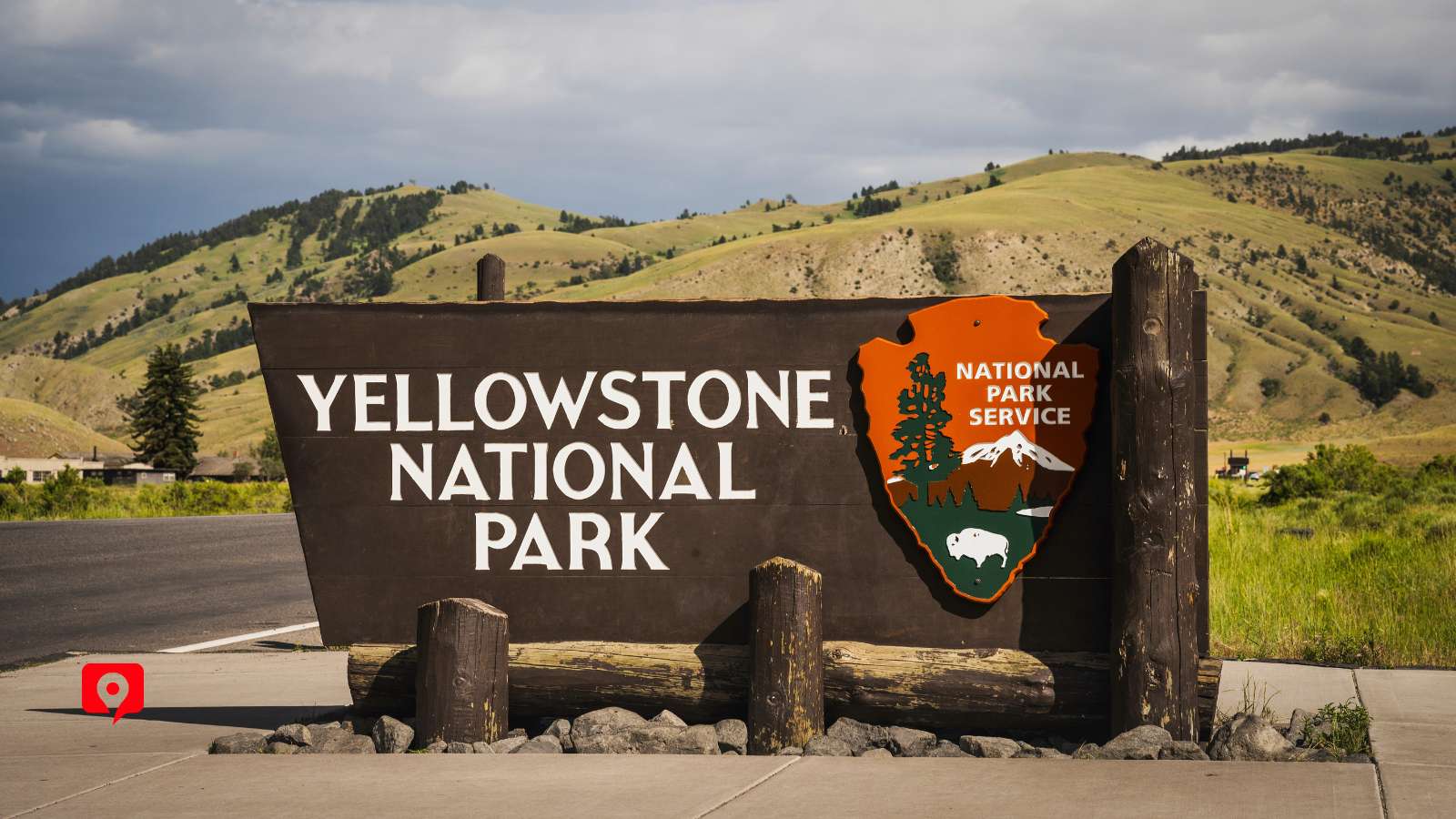
Visitors to the West Thumb in Yellowstone National Park must purchase a park pass, valid for seven consecutive days, at the park entrances or visitor centers, or online in advance. Depending on your travel plans and if you intend to visit multiple National Parks within a year, the America the Beautiful National Parks and Federal Recreational Lands Pass might be more cost-effective. This pass grants access to all U.S. National Parks, over 2,000 National Monuments, National Wildlife Refuges, National Historic Sites, and other federally managed lands.
Passes are complimentary for current U.S. military members and available at a reduced price for seniors aged 62 years or older. Seniors can also enjoy a 50% discount at certain campgrounds.
Have Kids in the 4th Grade?
You and your family can get free access to hundreds of parks, lands, and waters for an entire year!
When visiting West Thumb in Yellowstone National Park, accommodation options near Grant Village primarily consist of hotel rooms, equipped with convenient facilities like restaurants and a gift shop, enhancing your stay near Yellowstone’s attractions. Bookings for summer often open on May 1st and can fill up quickly, so planning ahead is crucial.
Yellowstone also features twelve campgrounds, five of which accept reservations. The rest are first-come, first-served, with early arrival recommended during peak season to secure a spot.
Choosing accommodations like Grant Village near the South Entrance is strategic, providing easier access to West Thumb and reducing travel time within the park. Early reservation is advised to ensure availability, especially during the busy summer months.
For more details on accommodations and bookings at Grant Village, visit Yellowstone National Park Lodges.
Outside of the Park
Securing lodging in Yellowstone National Park can be a challenge, especially during peak summer months. However, several accommodation options are available just outside the park to suit various budgets and preferences.
For West Thumb, the town of West Yellowstone, Montana, near the West Entrance, is highly convenient. It offers diverse lodging, dining, and entertainment options, making it a favored base for visitors. Gardiner, Montana, located near the North Entrance, also offers a variety of accommodations and easy access to the park. For those interested in Yellowstone’s eastern regions, Cooke City and Cody, Wyoming, are excellent choices. Both towns provide a range of lodging options and serve as ideal basecamps for exploring the park.
Visiting West Thumb in Yellowstone National Park is a year-round opportunity, each season offering its unique charm. Winter limits access due to heavy snow, while July and August mark the peak season with the largest crowds. For fewer visitors and milder weather, the shoulder seasons of April through May and September through October are ideal, though nighttime temperatures can drop to the 30s.
Summer brings dynamic weather, including frequent thunderstorms, and trails at higher elevations like West Thumb may remain snow-covered into late spring. Winter requires more preparation because of limited services but provides a peaceful setting for cross-country skiing and wildlife viewing, with potential sightings of bison, elk, and wolves. Each season at West Thumb showcases a different aspect of Yellowstone’s beauty, making any visit memorable based on your activities and preferences.
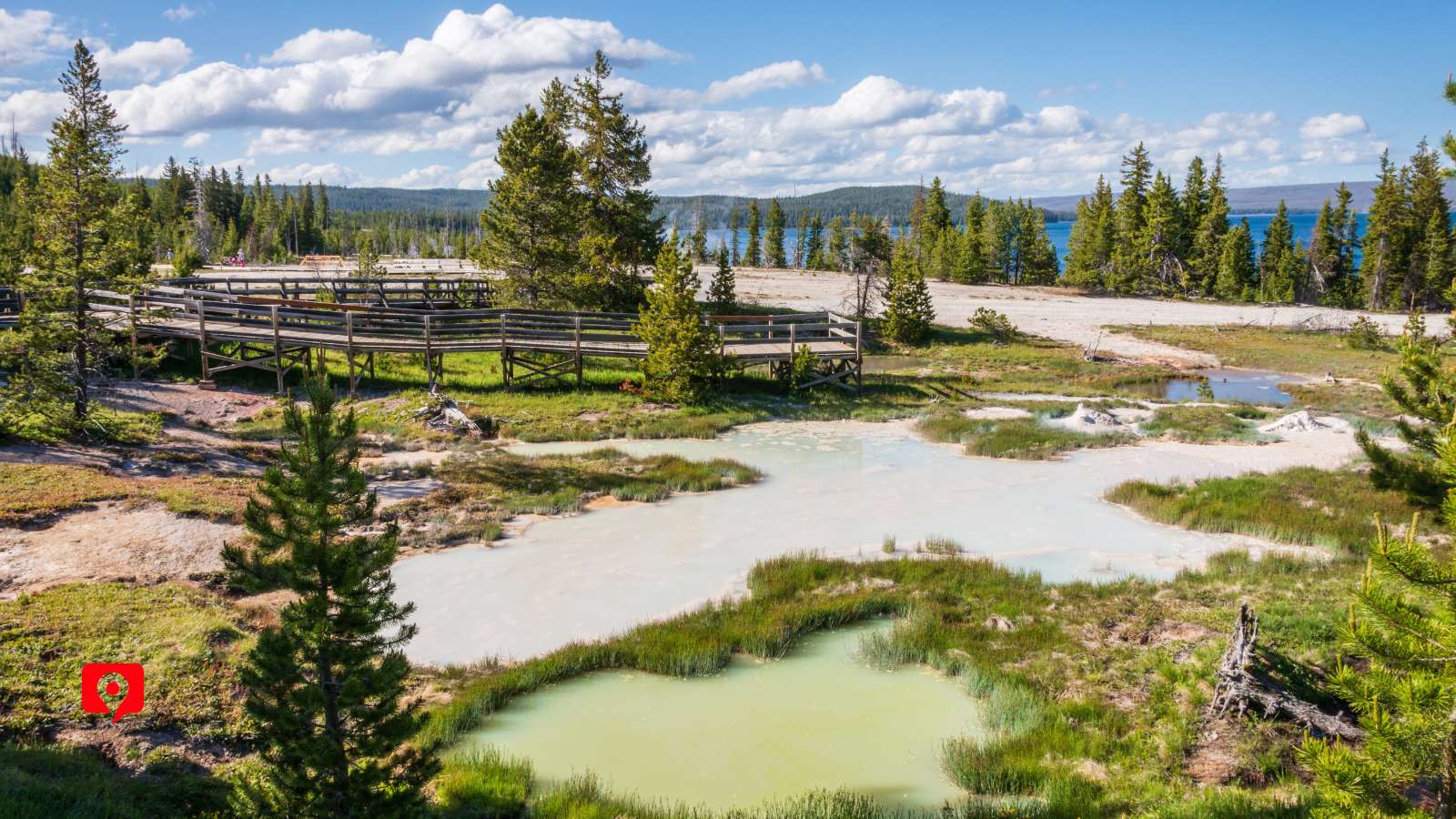
The West Thumb Geyser Basin trail offers a unique glimpse into Yellowstone’s hydrothermal wonders, all set against the backdrop of Yellowstone Lake. This easy, boardwalk loop showcases diverse geysers, hot springs, and mud pots. The loop itself is short, taking 30 minutes to an hour, leaving plenty of time for exploration and photos.
While West Thumb is often less congested than other Yellowstone hotspots, visiting during off-peak hours enhances the experience. Early mornings or late afternoons provide softer light for photography and a more peaceful ambiance, perfect for appreciating the geyser details and lake views.
Visiting during these quieter times also improves your chances of spotting wildlife along the lakeshore. Watch for birds, waterfowl, and maybe even elk or bison. Whether you’re a photographer or simply enjoy nature walks, West Thumb is rewarding, especially when visited during less crowded times.
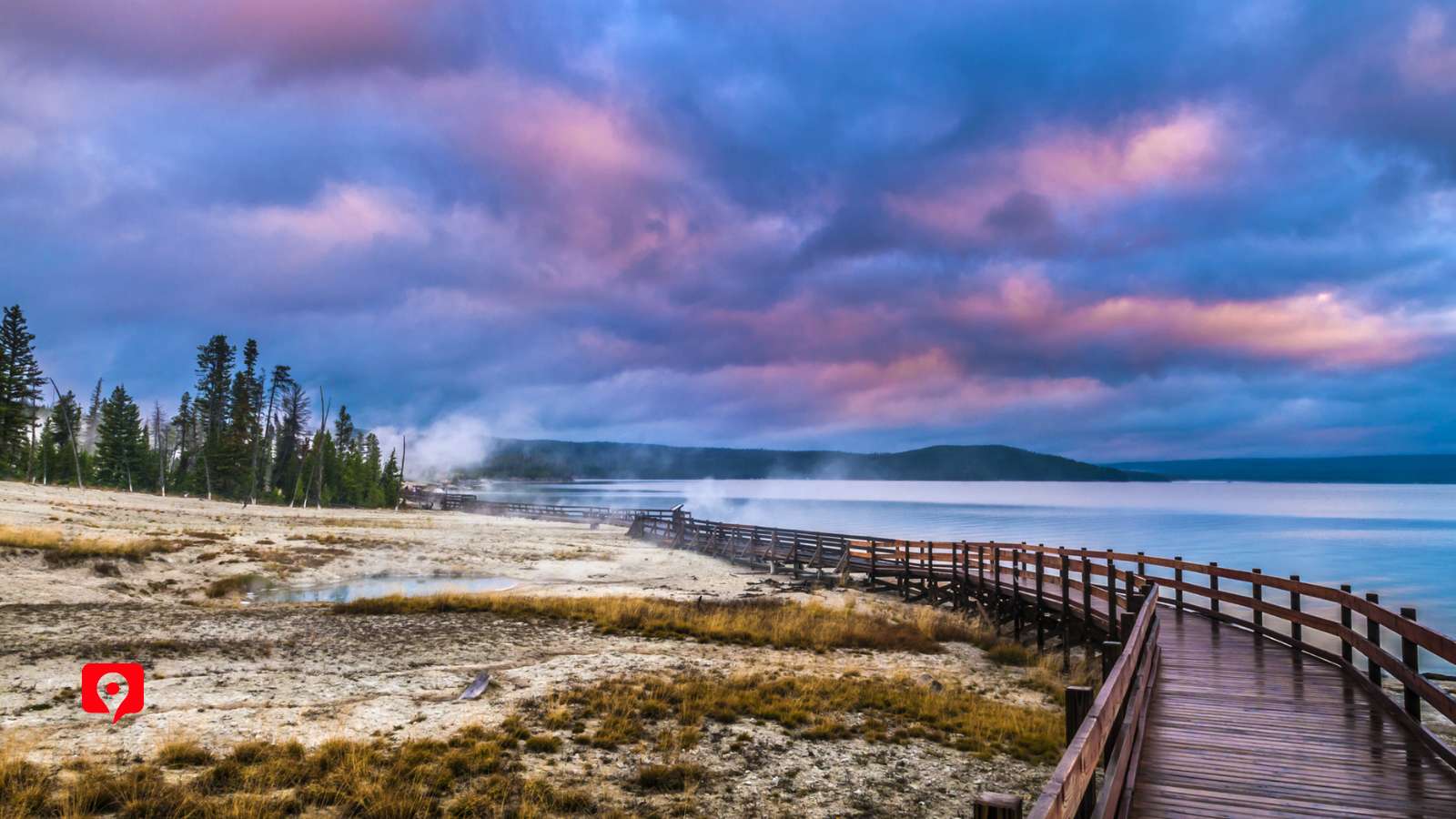
West Thumb Geyser Basin, a Yellowstone highlight, can get crowded, especially in July and August. For a more tranquil visit, aim for the shoulder seasons (May-June or September-October). If summer is your only option, visit early morning or late afternoon on weekdays to avoid peak crowds.
Beyond the boardwalks, explore less-trafficked trails along the lake for different geyser perspectives. While backcountry options near West Thumb are limited, nearby trails offer quieter moments. Staying inside Yellowstone Park significantly reduces travel time and allows for easier access during less crowded hours.
Park rangers and locals are great resources for hidden gems and unique activities near West Thumb. Ask for recommendations on quieter trails or viewpoints for a more personalized experience. By planning strategically and seeking local advice, you can enjoy West Thumb’s beauty with fewer interruptions and a deeper connection to its natural wonders.
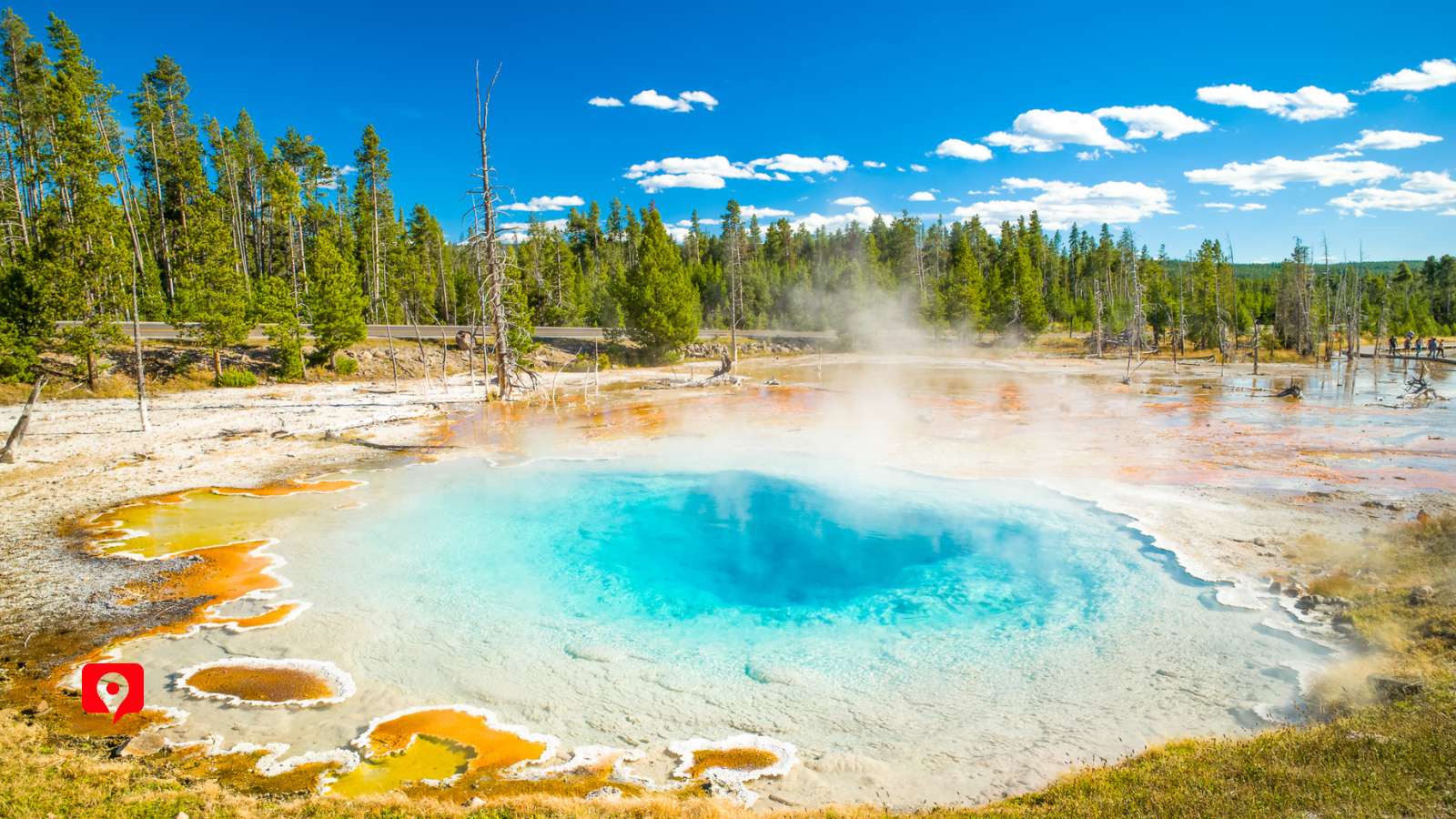
Thumb Geyser
Thumb Geyser, famous for its vibrant colors, is enriched by heat-loving bacteria in West Thumb Geyser Basin. In the mid-1970s, a mysterious decline in activity led scientists to speculate causes like slow pool refilling or rock changes. This decline, however, benefited thermophiles—microorganisms that thrive in heat—allowing them to create colorful mats around the geyser. These mats display a range of hues from yellow, red, and white in hotter zones to orange, brown, and green in cooler areas.
Blue Funnel Spring
Blue Funnel Spring, once 18 feet wide with temperatures from 172 to 182 degrees Fahrenheit, has cooled and redirected its water to nearby Abyss Pool over the past thirty years. Yellowstone’s thermal features hold deep spiritual significance for Native American tribes such as the Crow, Blackfeet, Flatheads, and Kiowas. Before European settlers, these tribes utilized the land’s resources, naming its natural wonders to honor the sacred hot springs and their powerful energies.
Abyss Pool
Visit Abyss Pool’s observation deck for a close look at one of Yellowstone’s deepest hot springs, plunging 53 feet deep. Three decades ago, Abyss Pool dramatically drained neighboring springs, including Blue Funnel. In 1987, it erupted spectacularly, fascinating both geologists and tourists. Today, equipped with seismometers and heat-resistant cameras, researchers strive to uncover the secrets of these thermal waters, ensuring they preserve the natural balance.
Fishing Cone
Fishing Cone, a geothermal feature in Yellowstone National Park, is steeped in history. In the late 1800s, it served as a natural “hot pot” where visitors would cook trout directly in its boiling waters—a novel yet perilous method, leading to several fatalities. This practice is now prohibited, and the geyser’s temperature has notably decreased over the years, reflecting changing geological conditions and increased conservation efforts to ensure visitor safety and preserve the natural environment.
Photography
West Thumb’s unique location along Yellowstone Lake offers photographers the chance to capture the contrast between the boiling hot springs and the cold lake waters. Early mornings or late evenings provide the best natural lighting, especially when the steam from the geysers is illuminated by the sun.
Canoeing and Kayaking
Engage in paddling sports like canoeing and kayaking at West Thumb. Easily accessible boat launches at Yellowstone Lake and Lewis Lake allow for tranquil water escapades. For a more secluded experience, you can paddle from Lewis Lake to the remote Shoshone Lake, navigating the connecting Lewis River. Remember to practice safety due to the chilly water temperatures and adhere to ecological protection guidelines by cleaning, draining, and drying your boats before and after entering the park waters.
Wildlife Viewing
The surrounding areas of West Thumb are rich in wildlife, including elk, deer, and occasionally bears. Early morning or twilight hours increase the chances of sightings as animals come out to feed in the cooler parts of the day.
Weather-Appropriate Clothing: Layers are key, as temperatures can fluctuate dramatically. Include a waterproof jacket for sudden rain showers and a warm layer for cooler temperatures, especially in the mornings and evenings.
Footwear: Wear comfortable hiking shoes or boots with good traction, suitable for walking on potentially wet boardwalks and uneven terrain.
Sun Protection: Bring a hat, sunglasses, and sunscreen. The sun can be intense at higher elevations, and there’s often little shade available on the boardwalk.
Portable Phone Charger and Cable: Since cell service can be spotty, having a portable charger ensures you can keep your phone charged, especially useful if you plan to take photos.
Camera and Binoculars: Don’t forget your camera to capture the stunning landscapes and thermal features. Binoculars can be handy for viewing distant wildlife safely and clearly.
Water and Snacks: Stay hydrated and keep your energy up with water and healthy snacks. There are no food services directly at West Thumb, so bring sufficient supplies.
Daypack: Carry a lightweight backpack to keep your hands free and to store your essentials like water, snacks, extra clothing, and your camera.
First Aid Kit: Always good to have on hand for minor injuries. Include basics like band-aids, antiseptic wipes, and pain relievers.
Eco-Friendly Trash Bag: Keep a small trash bag to carry any waste until you can dispose of it properly, helping to keep the park pristine.
Please fill out this form and let us know
17 Mile Drive Acadia Alberta Arches ARIZONA AUSTRALIA Badlands Banff Kamploos Big Bend National Park Big Island Big Sur Black Hills Blue Lagoon Bryce Canyon CALIFORNIA CANADA Canadian Rockies Canyonlands Capitol Reef Catskills COLORADO Crater Lake Cuyahoga Valley Death Valley Delicate Arch Everglades FLORIDA Florida Keys Freedom Trail Glacier Grand Canyon Grand Prismatic Grand Teton HAWAII Hidden Valley Hikes Honolulu Icefields Parkway Iceland Iceland Golden Circle Itineraries Joshua Tree Kancamagus Kauai Keweenaw Lake Superior North Shore Lake Tahoe Lassen Volcanic Lodging Louisiana MAINE Massachusetts Maui MICHIGAN Miinesota MINNESOTA Montana Mount Lemmon Mount Rushmore National Park NEVADA New Hampshire New Mexico New River Gorge NEW YORK NORTH CAROLINA North Cascades Oahu Ohio Old Faithful OREGON Redwood Reykjanes Peninsula Rocky Mountain Route 66 Saguaro Santa Fe Sedona Smokies Snæfellsnes Peninsula Sonoma And Napa Valley SOUTH DAKOTA Tech Tips TENNESSEE Texas Travel Tips Trip Planners USA UTAH Videos Waikiki WASHINGTON West Thumb West Virginia White Sands Wildlife WYOMING Yellowstone Yosemite Zion
